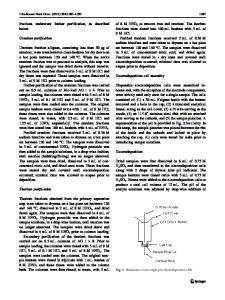Isotopic Fractionation of Thorium and Uranium upon Leaching of Monazite: Alpha-Recoil Damage Effects
- PDF / 512,091 Bytes
- 10 Pages / 420.48 x 639 pts Page_size
- 32 Downloads / 325 Views
V
Werner. huse, editor
ISOTOPIC FRACTIONATION OF THORIUM AND URANIUM UPON LEACHING OF MONAZITE:
ALPHA-RECOIL DAMAGE EFFECTS
YEHUDA EYAL Department of Nuclear Engineering Technion - Israel Institute of Technology, Haifa,
Israel
INTRODUCTION It has been proposed recently that high-level radioactive wastes from spent nuclear reactor fuels be converted into a crystalline phosphate form prior to their disposal in geological repositories.1 This approach is based on the known durability in nature of the mineral monazite, (Ce,La)P04 , which contains appreciable concentrations of thorium and uranium. 2 Of significance is the demonstrated resistance of monazite to excessive metamictization, in spite of the fact that the mineral has been subjected since its formation to radiation from the radioactive disintegration of 238U, 232Th and their many intermediate decay products. Nevertheless, radiation effects on the leaching behavior of the material in possible groundwater environments must be studied in the development and testing of monazite-like phases for the long-term disposal of fission product and actinide wastes. In a recent experiment,
3
three natural monazite specimens,
in which radia-
tion damage has accumulated over geological periods, were employed to investigate the relative dissolution rates of the actinide isotopes 238U, 234U, 232Th, 230Th and 2 2 8 Th. The minerals, containing 7.5-10.4 wt% 232Th and 0.13-0.23 wt% 238U, were subjected to a series of successive short-term leaching treatments in a bicarbonate-carbonate solution.
Preferential dissolution by a factor of
1.1 to v10 of the radiogenic nuclides 234U, 230Th and 228Th relative to their corresponding structurally incorporated isotopes served.
2 38
U and
232
Th has been obThis isotopic fractionation was attributed to radiation damage caused
by alpha-recoil atoms.
Each alpha-recoil atom produces a trail of displaced
atoms along a path a few hundred angstroms in length.
This damage causes a
local increase in the chemical reactivity of the mineral. The preferential transfer of the radiogenic isotopes to the solution may be explained by the preferential dissolution of the above damaged zones. Here we report the continuation of the study for one of the three monazite samples (monazite Ml from New Mexico in the United States).3 Ref. 3 the dissolution included 0.2% of the total
232
Whereas in
Th radioactivity present
in the mineral, here we present the leaching behavior up to dissolution of ,1l.8% of the total 232Th radioactivity. This investigation provides evidence
400
that radiation effects largely control the dissolution of the mineral in a well-developed stage of the leaching process.
In particular, it may be in-
ferred that etched alpha-recoil tracks provide a very effective means for the solution to penetrate into deep layers of the crystal.
This conclusion is
strongly supported by an additional experiment described here, that shows a pronounced decrease in the leach rate of the mineral after laboratory heat treatment.
The heat
Data Loading...











